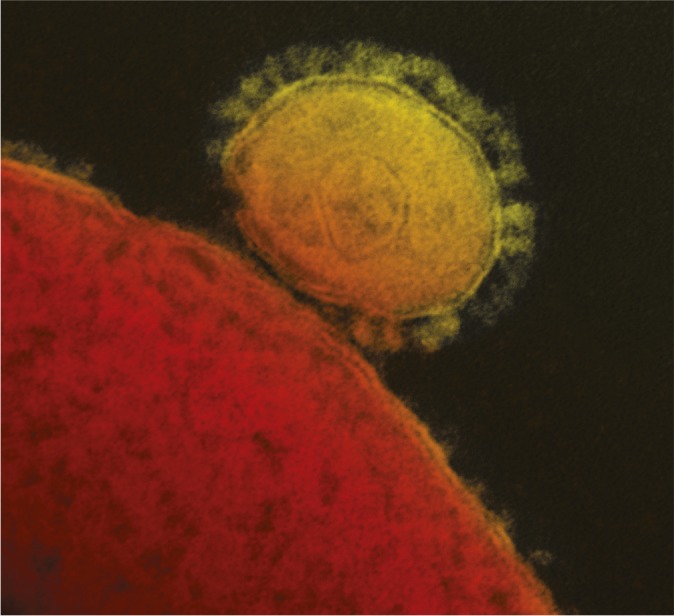Antibody against MERS

Transmission EM of MERS-CoV. Image courtesy of National Institute of Allergy and Infectious Diseases.
Middle East Respiratory Syndrome (MERS) is a severe infection of the lower respiratory tract caused by the MERS coronavirus (MERS-CoV), which has been responsible for over 1,300 human infections and 500 deaths since its discovery in 2012. No licensed vaccine or antiviral drug for MERS exists. Davide Corti et al. (pp. 10473–10478) isolated an antibody, named LCA60, from cultured memory B cells from a MERS-infected individual. LCA60 efficiently neutralized multiple strains of MERS-CoV. The antibody tightly bound to the viral S protein, which mediates recognition of host cells. Using a combination of mutagenesis and computational modeling, the authors determined that the antibody binds to a unique site on the S protein that partially overlaps with the binding site of the cell surface receptor CD26, and LCA60 blocked binding of the S protein to CD26, suggesting a possible mechanism for virus neutralization by LCA60. In mouse models of MERS, injection of LCA60 either before or after infection significantly reduced viral titers in the lungs, as did intranasal delivery of LCA60. In addition to providing a potential treatment for MERS, the results suggest a pathway for the rapid generation of antiviral therapies against emerging viruses, according to the authors. — B.D.
Climate and childhood undernutrition
Both the Intergovernmenal Panel on Climate Change and the World Health Organization report malnutrition as one of the most significant impacts of climate change on human health. Revati Phalkey et al. (pp. E4522–E4529) reviewed 15 studies that explored the association between climate/weather variability, crop yields, and undernutrition. Twelve studies report a significant association between weather variables and childhood undernutrition, whereas eight studies report a correlation between exposure to extreme weather events, such as drought or flooding, and undernutrition. Other factors examined include temperature, cultivated land area, crop yield, and the effects of household size, socioeconomic status, and demographic variables. A study from Papua New Guinea reported that household socioeconomic factors predicted childhood undernutrition better than environmental or agricultural factors. Although 80% of the studies report a correlation between one or more weather variables and undernutrition, further studies based on long-term primary data on a range of factors at the household level, including agricultural, environmental, socioeconomic, and health factors, will likely be required to validate the impact of climate change on the health and growth of children, particularly for families that rely on subsistence farming, according to the authors. — P.G.
Enhanced genome editing helps engineer T cells

Enhanced genome editing for T cells. Image courtesy of iStockphoto/zmeel.
Despite recent advances in genome editing using the clustered regularly interspaced short palindromic repeats (CRISPR)/CRISPR associated protein 9 (Cas9) tool, efficient and specific editing of human T-cell genomes has remained a challenge. Using Cas9 ribonucleoproteins (Cas9 RNPs), composed of Cas9 proteins and lab-generated single-guide RNA molecules, Kathrin Schumann et al. (pp. 10437–10442) efficiently and specifically edited the DNA sequence of CXCR4, which encodes an immune receptor on the surface of human helper T cells that enables HIV infection, isolated the modified cells using a cell sorting technique that targeted the edited protein, and confirmed the edits using deep sequencing. Further, the authors combined Cas9 RNPs and a custom-designed single-stranded DNA molecule known as a homology-directed repair template to selectively replace nucleotides in CXCR4 in human T cells isolated from healthy donors. Using a similar approach, the authors demonstrated targeted nucleotide replacement with up to 20% efficiency in PD1, which encodes an immune checkpoint protein on human T cells that is an established target of cancer immunotherapies. Because the short-lived Cas9 RNPs are typically degraded 24 hours after delivery into cells, they may be safer than approaches that expose cells to Cas9 for long periods in strategies aimed at engineering primary human T cells to combat immune system disorders, according to the authors. — P.N.
Length measurement using chemical waves
To carry out many biological processes, living things must measure and regulate the lengths of various body parts and organs, but the mechanisms of length determination in living things remain unclear. Robert Laughlin (pp. 10371–10376) suggests that living things might generate and use chemical waves for length determination. The author demonstrates how properly tuned conventional biochemical reactions can convert random diffusion motion into linear waves with a stable speed, and that these waves naturally reflect off distant surfaces. Such a mechanism would allow lengths to be measured using principles similar to those of laser rangefinders. One of the advantages of this engineering strategy is that it could be used in many types of structures of different shapes and sizes. The author suggests that such plasticity makes waves a good candidate for how living things might generally measure lengths, and points out that there is a precedent in Escherichia coli, which uses chemical potential waves to detect the midpoint for cell division. The author suggests that the inherent difficulty of detecting chemical waves with currently slow laboratory techniques may explain why such waves have not been widely reported. According to the author, such chemical waves may play a role during the process of mitosis. — S.R.
Role of glutathione in cancer
Triple negative breast cancer (TNBC) is particularly aggressive and cannot be treated by targeted therapy. Chemotherapy for TNBC leads to enrichment of breast cancer stem cells (BCSCs), which possess both enhanced drug resistance and the ability to metastasize through activation of the master gene regulator hypoxia-inducible factor (HIF)-1. Haiquan Lu et al. (pp. E4600–E4609) traced the pathway that leads from drug-induced activation of HIF-1 to BCSC formation. In TNBC cell lines treated with anticancer drugs, HIF1 induced the expression of proteins required for glutathione synthesis. Glutathione caused FoxO3, a transcription factor, to localize to the nucleus and activate a set of genes encoding pluripotency factors, which induce the BCSC phenotype. Surprisingly, glutathione’s role in this process did not appear to involve reduction of oxidative stress, as exposure to another antioxidant failed to activate FoxO3 or induce expression of downstream genes. Instead, the authors found that glutathione acted by chelating copper, a cofactor for the MEK1 signal transduction protein. When copper was depleted, MEK1 failed to activate the enzyme ERK kinase, which restrains FoxO3 from translocating to the nucleus. Hence, the authors caution against the use of glutathione, copper chelators, and MEK1-ERK inhibitors to treat cancer. However, inhibition of HIF-1 may reduce the likelihood of BCSC formation during chemotherapy, according to the authors. — C.B.
Adaptation to altitudes in Ethiopian highlanders

Ethiopian highlands. Image courtesy of Flickr/Justin Clements.
Whole genome analysis of Ethiopian highlanders, who live in low-oxygen conditions, has pinpointed genes linked to adaptation to hypoxia. Tsering Stobdan et al. (pp. 10425–10430) tested the role of one such gene product, Endothelin receptor B (EDNRB), a signaling receptor implicated in cardiac function, in adaptation to high altitudes. In the highlanders’ genomes, the authors identified several nucleotide base changes in the region harboring EDNRB that encompassed sequences previously identified as binding sites for gene switches linked to cardiac function. When exposed to moderate or extreme hypoxia, engineered mice with only one functional copy of EDNRB displayed better cardiac performance and oxygenation of vital organs than wild-type mice. Gene expression analysis identified several genes that were conversely regulated in wild-type and mutant mice. Of these, three genes—Nppa, Sln, and Myl4—were found to be implicated in cellular pathways tied to calcium regulation, heart contraction, and blood circulation, likely explaining the superior cardiac function in the mutant mice under severe hypoxia. Hence, the authors suggest, lowering levels of EDNRB helps preserve cardiac function under moderate to severe hypoxia not only at high altitudes but also at sea level. According to the authors, the findings explain how EDNRB mediates adaptation to high altitudes and identify the receptor as a potential therapeutic target for conditions involving hypoxia. — P.N.


